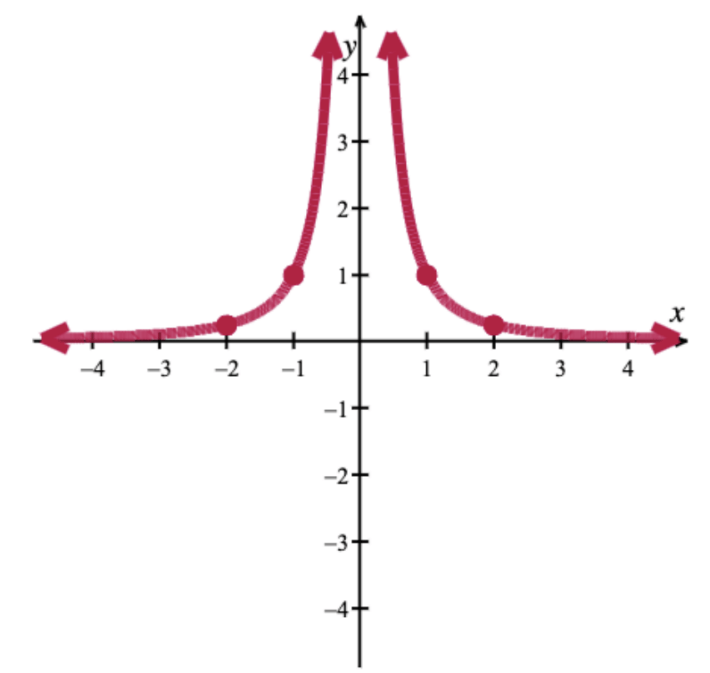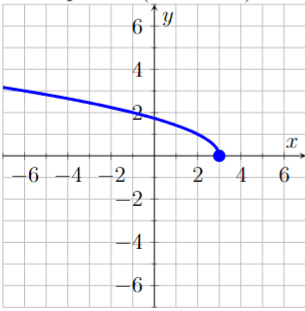This is the domain for the parent function
f(x)=1/x
What is
(-\infty,0)\cup(0,\infty)?
This is a behavior we observe when functions have negative slope on an interval, i.e., as you move from left to right, the value of the function keeps falling.
What is decreasing?
This type of transformation shifts the graph left to right or up to down.
What is a rigid transformation OR (vertical/horizontal) translation?
What are the five operations that appear in combination of functions?
What is addition, subtraction, multiplication, division, and composition?
What is an inverse?
This is a technique that is used to derive the vertex form of a quadratic function.
What is completing the square?
The domain and range of the graphed function:
What is
(-\infty,2)\cup(2,4)\text{ and }[-2,\infty)?
This type of function holds a property of having rotational symmetry around the origin.
What is an odd function?
This type of transformation occurs when the scaling constant of the function is negative.
What is a reflection?
Consider the following table:
 This is the evaluation of
This is the evaluation of
(g/f)(-1)
What is -3?
This is the result we get when we compose a function it its own inverse.
What is
(f\circ\f^-1)(x)=x?
This is the vertex form written algebraically.
What is
f(x)=a(x-h)^2+k?
The domain of the quadratic function:
f(x)=-2(x-1)^2+5
What is
(-\infty,5)?
This function is either odd, even, or neither.
f(x)=root(3)(2-x^2
What is even?
This is the general formula of the transformation form of a function.
What is
y=Af(B(x-h))+k?
Consider the functions
f(t)=t^2+3, g(t)=\sqrt(t-2)
This is the composition
(f\circg)(t).
What is
t+1?
The inverse of the function:
h(x)=(4x-1)/(2x)
What is
h^-1(x)=-1/(2x-4)?
This is the x-intercepts of the following quadratic function:
f(x)=3(x-3)^2-4
What is
(3+\sqrt(4/3),0),(3-\sqrt(4/3),0)?
The domain of the following function:
g(x)=(\sqrt(4x-2))/(x^2-16)
What is
[1/2,4)\cup(4,\infty)?
This is the function that is even, possesses the domain of
(-\infty,0)\cup(0,\infty)
and behaves as the graph:

What is
f(x)=1/x^2
or the squared reciprocal function?
The formula of the transformed function:

What is
f(x)=\sqrt(3-x)?
(DAILY DOUBLE) This is the process in finding the domain of the function resulting in division:
f(x)/g(x)
What is determining the domain of f and g and excluding points where x = 0?
The inverse for the function:
f(x)=-root(3)(x+1)+2
What is
f^-1(x)=(2-x)^3+1?
These are the roots/zeroes of the following function:
f(x)=(4x-1)^2-2(4x-1)+1
What is
x=1/2?
The range of the inverse function for a given domain of the function:
[-3,2)\cup(2,\infty)
What is
[-3,2)\cup(2,\infty)?
(DAILY DOUBLE) This is the piecewise function of the following graph:

What is
f(x)={((x-4)^2, x<-2),(abs{x}-3,-2<=x<=2),(\sqrt{8-x},x>2):}
Why isn't there typically a horizontal scaling component B (in the transformation form) in a quadratic function?
Because it can be rewritten as a horizontal scaling component itself:
f(x)=x^2
f(2x)=(2x)^2
f(2x)=4x^2
where A = 4.
Consider the functions
f(x)=2+1/x, g(x)=x^2+5x
This is the domain of the composite function
(f\circg)(x)
What is
(-\infty,-5)\cup(-5,0)\cup(0,\infty)?
This graphical behavior is only observed when all the points from the inverse maps on the original function.
What is "the function is its own inverse", i.e.
f(x)=f^-1(x)?
A rancher has 240 feet of fence with which to enclose three sides of a rectangular pasture (the fourth side is a river and will not require fencing). The answer is the dimensions of the pasture with the largest possible area.
What is 120ft x 60ft?